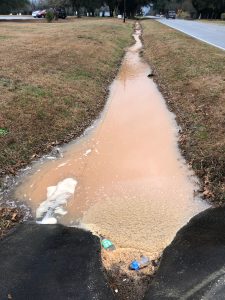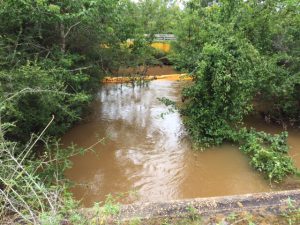
Dirt in the water doesn’t seem like it should be a big deal. I mean, there’s dirt everywhere, right? The seafloor is made up of sand, muck, or some type of soil—surely it’s natural. But like most things, an excessive amount of something, even if naturally present in the environment, can be of major consequence.
As is typical in the summer, a recent afternoon thunderstorm brought with it a torrential downpour. During the storm I came across a construction site with no erosion controls installed. Erosion controls are required at any site where dirt—especially red clay—is being moved around, and often consists of measures like hay bales or silt fences. If installed correctly (and often, they are not), they form a barrier that prevents construction dirt from running off-site. At this location there were none in sight, and I watched as red clay flushed off the site, down the street, and into the storm drain.

Multiply this small site by hundreds, even thousands, of active construction sites and dirt roads in your county and imagine the flow of dirt. Once this material enters a storm drain, it will often find its way to the nearest water body. When soil, especially clay, is suspended in the water it turns the clear water opaque—a phenomenon called turbidity. Turbidity can be measured in a lab from a water sample, looking at total suspended solids. The state of Florida has statutes making certain levels of turbidity illegal, and property owners or construction companies can be held liable and fined if the sediment source can be traced to its origin. This is often easy to do, as the sediment leaves a visible trail from construction site to water body.

Besides discoloring the water, leaving it unsightly, and wasting a lot of money on fill dirt, there are true environmental impacts from that turbidity. Seagrasses are totally submerged underwater and grow on the seafloor. They are true grasses, requiring sunlight to photosynthesize. If the water is cloudy and turbid, grasses cannot grow healthily, and beds will eventually get sparse and bare. The lack of large swaths of healthy seagrass beds are indicators of impaired water quality and prevent us from having the scallop and horseshoe crab populations once found in local waters.
After suspended sediment settles out of the water column, it builds up on the seabed. This collection of course material can bury and choke out not only grasses, but the macroinvertebrates (insects, worms, arthropods, etc.) that compose much of the base of the food web. If these building blocks are removed, there are cascading effects up the food chain as larger organisms move off or die out due to lack of food sources.
So—that’s why dirt in the water matters. If you are involved in a building project or see one without appropriate erosion controls, speak up and let those responsible know. This is a type of environmental impact that is very easy to avoid by being diligent with best management practices.
 7
7
